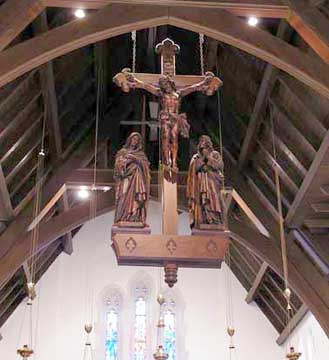Illustrated Architecture Dictionary
Rood

A crucifix, especially one positioned above the rood screen of a church or on a beam over the entrance to the chancel.
Large crucifix high in a church; most medieval Western churches had one, often with figures of the Virgin Mary and John the Evangelist alongside, and often mounted on a rood beam or rood screen
Rood screen: a screen, typically of richly carved wood or stone, separating the nave from the chancel of a church. The rood screen was a physical and symbolic barrier, separating the chancel, the domain of the clergy, from the nave where lay people gathered to worship. Often it was solid only to waist height and richly decorated with pictures of saints and angels; sometimes the rood screen was elevated. Rood screens are found throughout western Europe and date chiefly from the 14th–16th centuries.
Iconostasis: Every Orthodox Christian church has an iconostasis which is like a rood screen.
Rood screen, in Western architecture, element of a Christian church of the Middle Ages or early Renaissance that separated the choir or chancel (the area around the altar) from the nave (the area set apart for the laity). The rood screen was erected in association with the rood, which in Old English means “cross,” or “crucifix.”
At first the great rood of a medieval church was supported by a single beam, spanning the nave at the entrance to the chancel and known as the rood beam. Later a rood screen was added, rising from the floor to this beam; the rood loft, above the screen, was also added. Upon this loft, or gallery, were displayed the rood [CRUCIFIX] and the two statues (of the Virgin Mary and St. John) that usually flanked it. The loft also held candles to be lighted on festival days. Because minstrels performed there on special occasions, the loft was also known as the singing gallery. The rood stairs, either built into the stone wall of the chancel or housed in a freestanding turret, rose from the church floor to the loft.
In 16th-century England, with Henry VIII’s establishment of the Anglican church, it was decreed that the rood and everything else above the rood beam had to be removed. Rood screens were allowed to remain, but thereafter they were more often called chancel screens. Some English rood screens have escaped destruction, and some have been restored. Late Renaissance church architects preferred an unbroken view into the chancel from the nave, so by 1800 the rood screen and loft had become virtually obsolete throughout Europe. Nonetheless, in the 19th and early 20th centuries, churches in the Gothic Revival style frequently reintroduced rood screens.
Examples from Buffalo architecture::
- Illustration above: St. Andrew's Episcopal Church
- First Presbyterian Church
Other examples: